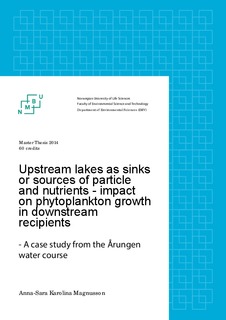| dc.contributor.author | Magnusson, Anna-Sara Karolina | |
| dc.date.accessioned | 2014-09-24T11:17:33Z | |
| dc.date.available | 2014-09-24T11:17:33Z | |
| dc.date.copyright | 2014 | |
| dc.date.issued | 2014-09-24 | |
| dc.identifier.uri | http://hdl.handle.net/11250/221432 | |
| dc.description.abstract | Two lakes situated in the same catchment in SE Norway were studied during the growing season of 2013. Lake Østensjøvannet is a small and shallow lake situated upstream from a larger and deeper recipient, Lake Årungen. The objective was to determine to what extent the water quality in Lake Årungen is influenced by processes in Lake Østensjøvannet.
The fieldwork was carried out during the growing season of 2013. The water samples were collected from vertical depth series in the lakes. Water samples were collected at an upstream and downstream location in the connecting stream, and discharge measurements were carried out at a turbulent section of the stream. Physical, chemical and biological analysis of the water quality was preformed according to Norwegian standards.
The physical, chemical and biological differences were evaluated and were related to morphometric and hydrological characteristics and limiting factors for phytoplankton growth. The phytoplankton composition was compared in the two lakes to determine the level of interconnection between the lakes. The nutrient retention capacity was evaluated in the upstream lake with focus on internal phosphorus loading. Retention of different water chemical variables in the interconnecting stream was evaluated at different discharge intensities.
The stability of the stratification regime was governed by lake size and volume. The mixing barrier in Lake Østensjøvannet was less resistant against wind force, which resulted in homogenous vertical concentration distribution of chemical parameters. Low precipitation during the second half of the season however resulted in steeper vertical gradients. The vertical mixing of the water column was determining for phytoplankton composition. At shallow mixing and low insolation, phytoplankton groups with abilities for vertical positioning were favored. Shallow mixing was limiting for diatom algae in both lakes at the first half of the season, while nutrient limitation caused the diatom decline in Lake Årungen. The phytoplankton growth in Lake Østensjøvannet was dominated by autotrophic picoplankton at the latter half of the season. Transport of algae cells downstream was limited by increased retention time and low discharge. The upstream lake retain particles and nutrients, however the retention efficiency was increased as a result of prolonged retention time. Internal phosphorus loading in Lake Østensjøvannet was not supported by this study. Retention of particles and total phosphorus occurs in the combining stream during low flow. However, phosphate was increased downstream which could have consequences for the phytoplankton growth in the recipient. | nb_NO |
| dc.language.iso | eng | nb_NO |
| dc.publisher | Norwegian University of Life Sciences, Ås | |
| dc.subject | VDP::Matematikk og Naturvitenskap: 400::Zoologiske og botaniske fag: 480::Limnologi: 498 | nb_NO |
| dc.title | Upstream lakes as sinks or sources of particles and nutrients - impact on phytoplankton growth in downstream recipinents : a case study from the Årungen water course | nb_NO |
| dc.type | Master thesis | nb_NO |
| dc.source.pagenumber | 107 | nb_NO |
| dc.description.localcode | M-MINA | nb_NO |
